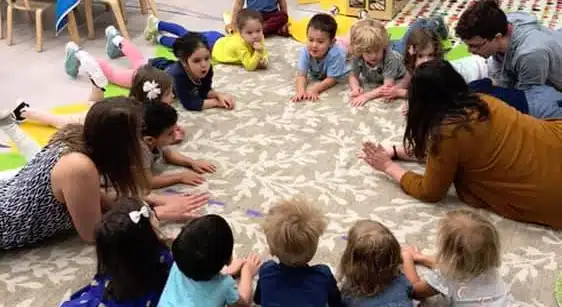Mornings are rough. Especially for parents and caregivers who have to load up their little ones (and all of their stuff), and fight though rush hour to make it to school drop-off in time. Now, if you also have to factor in a toddler or preschooler who fights you every step of the way… it can make your mornings feel impossible. But, if you are able to understand from a developmental perspective why your child is having a hard time and put strategies in place to help them, it will get so much easier!
Two things that the developing brain of a 2-5 year old struggle the most with are transitions, and having a sense of control over their daily life.
If you think about it, going from being at home (playing with caregiver and their own toys) to getting into the car, to getting into school and getting settled are a LOT of transitions all in a row. And all of those transitions are things that your child likely has little to no control over. So, even if your child is resisting (aka: throwing a tantrum) you should do your best to keep the morning going, so your school routine is not disrupted. Once you give into demands and allow a stay home day, it will be so much harder to get back on track.
Here are some strategies to make your morning routine a smooth one:
- Give a 3-5 minute warning before it is time to stop what you are doing and get in the car
- Set a timer
- Try talking through every step of the process of the morning, even starting the night before at bedtime
- In addition to talking through your morning routine, you could also make a picture schedule and check things off as you complete them each day
- Ask your child’s teacher to provide photos of the fun they have at school so you can refer back to them, and remind your little one that they do in fact enjoy school
- Don’t negotiate, instead give choices! Be calm and firm and say “We are going to school. Staying home is not a choice right now. Would you like to hold my hand, or walk by yourself to the car? Which do you choose?” Offering some small choice in how the transitions are completed will provide that sense of control your child might be craving.
- If you’re wavering too much, they will sense it and try to take control of the situation themselves. 2-5 year olds are experts at this!
It can also be helpful to touch base often with your child’s teachers to make sure that they are recovering from a rougher morning in an appropriate amount of time. Usually we see tears fade away within minutes, and most kiddos are playing happily right after their grown-up is out the door. If this is not the case and you think your child is struggling with separation anxiety check out this blog for more helpful tips.
Remember to have confidence in yourself as the caregiver. It’s not an easy job, and you are doing great! We promise.

Samantha Perry
Samantha Perry is the Director of Bubbles Academy’s Arts-Integrated Preschool Program. She is also the recipient of the Harris Foundation’s Scholarship for Excellence in Leadership and received her Master of Science in Child Development with a specialization in Administration at Erikson Institute. The Harris Excellence Scholarships are awarded annually to a select number of students with excellent academic credentials and a demonstrated commitment to the field of early childhood.
Sam is grateful for the opportunity to use both her theatrical expertise, and broad knowledge of needs of young children at Bubbles Academy’s arts-integrated preschool program. As an educator, Sam strives to inspire confidence, independence, curiosity and creativity in each of her students every day.
